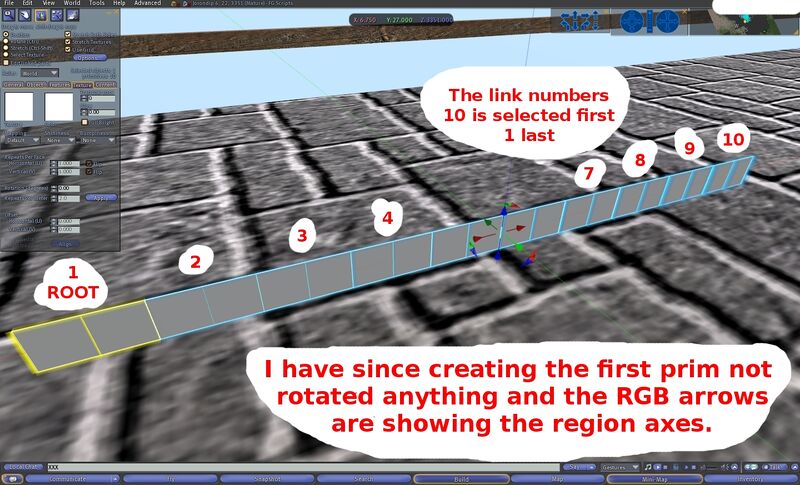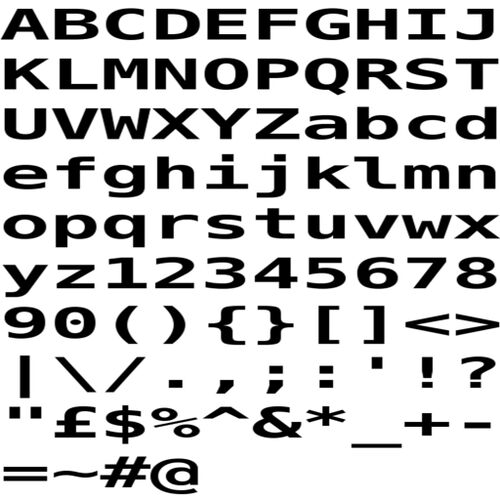Difference between revisions of "User:Fred Gandt/Scripts/Continued 4"
Fred Gandt (talk | contribs) m (→Control Script: Added note about caveat) |
Fred Gandt (talk | contribs) m (→PJIRA Issue Tracker: None of those were exiting) |
||
| Line 33: | Line 33: | ||
=== PJIRA Issue Tracker === | === PJIRA Issue Tracker === | ||
'''[http://jira.secondlife.com/secure/IssueNavigator.jspa?reset=true&&reporterSelect=specificuser&reporter=Fred+Gandt | '''[http://jira.secondlife.com/secure/IssueNavigator.jspa?reset=true&&reporterSelect=specificuser&reporter=Fred+Gandt The issues I have filed on the PJIRA]''' | ||
== Tuition == | == Tuition == | ||
Revision as of 15:17, 30 April 2010
| LSL Portal | Functions | Events | Types | Operators | Constants | Flow Control | Script Library | Categorized Library | Tutorials |
My Contributions
If unsure about how to use these scripts
I have implemented a V# system to make it more obvious if a script is updated. The V# forms part of the title of each script.
If you have any comments about the content of this page please post them HERE
All my scripts are written for compilation as MONO
More Pages
Free Scripts (content constantly updating)
More Free Scripts (content constantly updating)
Even More Free Scripts (content constantly updating)
Even More More Free Scripts (content constantly updating)
Even More More More Free Scripts (this page)
Legal Stuff
The legal stuff about contributing to this wiki (worth reading).
PJIRA Issue Tracker
The issues I have filed on the PJIRA
Tuition
Tuition scripts, notes, videos and screenshots etc. (hardly any content yet)
Free Scripts
Text Scroller (3 Scripts) ( V1 )
A simple text display unit that scrolls text from right to left (like those LED signs) in a continuous loop. Touch to start and stop the scrolling. It is not very sophisticated.
Create The Object
- Create a fresh new prim and drop this script onto/into it. The prim will form the shape needed plus change the texturing etc. (you can do what you like to the texturing afterwards)
<lsl>// V2 //
default {
state_entry()
{
llSetPrimitiveParams([7, <0.5, 0.01, 0.25>, // Set the size
8, <0.0, 0.0, 0.0, 1.0>, // Set to ZERO_ROTATION
9, 0, 0, <0.375, 0.875, 0.0>, 0.0, <0.0, 0.0, 0.0>, <1.0, 1.0, 0.0>, <0.0, 0.0, 0.0>, // Shape the prim
17, -1, "5748decc-f629-461c-9a36-a35a221fe21f", <1.0, 1.0, 0.0>, <0.0, 0.0, 0.0>, 0.0, // Apply the blank texture
18, -1, <1.0, 0.65, 0.1>, 1.0, // Color the prim (kinda orange)
20, -1, 1, // Make fullbright
25, -1, 0.05]); // Slight glow
llRemoveInventory(llGetScriptName()); // Remove the script when done
}
}</lsl>
- When the script has worked its magic, Snap the prim to the grid with a grid size of .5 meters.
- Shift-Drag-Copy the prim, snapping each to the grid positively along the X axis until you have 10 prims in a continuous strip.
You can actually make the object as long or short as you like. 1 prim will work. 100 prims will work (although large linksets have been a problem for link_messages in the past). Just follow the same basic build plan.
- Select each of the prims from the end that has the greatest X axis position, one at a time (negatively along the X axis) until ALL are selected.
- Link the set.
Display Script
- Check "Edit Linked parts" and select one prim at a time, dropping this script in each.
- DO NOT CREATE A FRESH SCRIPT IN EACH PRIM. DROP THE SAME SCRIPT FROM YOUR INVENTORY INTO EACH PRIM.
<lsl>// V1 //
string font = "ABCDEFGHIJKLMNOPQRSTUVWXYZabcdefghijklmnopqrstuvwxyz1234567890(){}[]<>|\\/.,;:'!?\"£$%^&*_+-=~#@ "; // A accurate representation of the characters featured on the texture used to display the text.
vector GetOffset(string s) {
if(s == "") // If there is no text
s = " "; // Use a space
integer i = llSubStringIndex(font, s); // Find the character
if(i == -1) // If we can't find it
i = 94; // Use a space
return <(-0.45 + ((i % 10) * 0.1)), (0.45 - (llRound(i / 10) * 0.1)), 0.0>;
} // Return the offset needed to display the correct section of the texture by doing the mathematics *coughs*
integer me; // Used to store the Link number
integer my_ss_5; // Used to store the index of the feed text we display on face 5
integer my_ss_6; // Used to store the index of the feed text we display on face 6
default {
state_entry()
{
me = llGetLinkNumber();
my_ss_6 = ((me - 1) * 2); // Whatever link we are (in a correctly built object) establish the index to grab
my_ss_5 = (my_ss_6 + 1); // And also grab the next
}
link_message(integer sender, integer num, string msg, key id)
{
llSetLinkPrimitiveParamsFast(me, [17, 5, id, <0.1, 0.1, 0.0>, GetOffset(llGetSubString(msg, my_ss_5, my_ss_5)), 0.0,
17, 6, id, <0.1, 0.1, 0.0>, GetOffset(llGetSubString(msg, my_ss_6, my_ss_6)), 0.0]);
} // Set the texture to the correct offset to display the correct characters
}</lsl>
Control Script
One possible way amongst many to feed the text to the script is by notecard. That is the way I set this script. As such, you need a notecard in the root containing the text you wish to display. One notecard will be read. If you add more notecards (without altering the script) it will read the first it finds alphabetically.
- There is a caveat regarding the length of the lines of text in the notecard. If the line is longer then 255 bytes the dataserver will return the first 255 bytes of the line.
- This example - taken from one of Shakespeare's Hamlet's soliloques (To be, or not to be?...) is too long by the red lettering -
- "For who would bear the whips and scorns of time, th'oppressor's wrong, the proud man's contumely, the pangs of despised love, the law's delay, the insolence of office, and the spurns that patient merit of th'unworthy takes, when he himself might his quietus make with a bare bodkin?"
- Add your text notecard to the root.
- Drop this script into the root.
<lsl>// V1 //
integer count; // Used to keep track of itterations
integer length; // A measure of string length
string text = " "; // Adding this creates a gap between beginning and end of text
integer NCC; // NoteCardCount for tracking which line to read
string NC; // NoteCard name
integer on; // Are we on or off?
default {
state_entry()
{
NC = llGetInventoryName(INVENTORY_NOTECARD, 0); // Establish the name of our NC
llGetNotecardLine(NC, NCC); // Ask for the first line
}
dataserver(key q, string data)
{
if(data != EOF) // If the data is useful
{
text += (data + " "); // Store it
llGetNotecardLine(NC, (++NCC)); // And get the next line
}
else // If not useful we are at the end of the NC
{
length = llStringLength(text); // Establish the length of our text
// The number 19 is 1 less than the number of faces (2 per prim) that display text. Change that number accordingly if...
// ...you have a larger or smaller number of prims in your object.
llMessageLinked(-1, 0, llGetSubString("Touch start scroll.", count, (count + 19)), "b6349d2d-56bf-4c18-4859-7db0771990a5");
} // Message the display scripts that we are ready to function
}
timer()
{
if(count == length) // If we have gone full circle
count = 0; // Start again
llMessageLinked(-1, 0, llGetSubString(text, count, (count + 19)), "b6349d2d-56bf-4c18-4859-7db0771990a5");
++count; // Message the display scripts with a chunk of text
}
touch_end(integer nd)
{
if(on) // Are we running?
llSetTimerEvent(0.0); // Stop the timer
else // No?
llSetTimerEvent(0.15); // Start the timer
on = (!on); // Remember what we did
}
changed(integer change)
{
if(change & CHANGED_INVENTORY) // If the inventory has changed the NC may have
llResetScript(); // So reset the script to read the new card
}
}</lsl>
It should set the text to read "Touch Start Scroll.". If you get something else, you haven't followed these instructions.
The Charsheet Texture
I am a scriptor, not a texturizerer. I created a very simple Charsheet (Character Sheet) to get you going but, it isn't very good *grins*. You will probably want to replace it.
- The texture MUST be 10 characters by 10 characters (you may have empty spaces so, 56 chars is fine so long as the grid is the full 100 spaces).
- Unlike the texture I have supplied...ALL the chars should be perfectly evenly spaced and not spreading into the neighboring spaces.
This is the texture supplied. You don't need to copy this. The script already has the UUID in it.
The display scripts contain a string that is in the exact same order the chars are read from top left to bottom right (row by row, not column by column).
- HAVING THE SAME ORDER OF CHARS IN THE TEXTURE AND STRING IS VITAL
The order you choose is entirely up to you as long as the strings in ALL the display scripts match the order of chars in the texture.
- Don't forget to include a blank grid space on your 10 x 10 texture for a space "character". There also needs to be an empty space (in the correct place) in the scripts.
- In the display script strings there are two characters that must be treated unusually. The \ and the " must have a \ placed before them.
- Example "ABCabc123.,:\"\\/| " Note the included space and the way the \ and " have a \ before them.
More Scripts...
Free Scripts (content constantly updating)
More Free Scripts (content constantly updating)
Even More Free Scripts (content constantly updating)
Even More More Free Scripts (content constantly updating)
Even More More More Free Scripts (this page)
If you have any comments about the content of this page please post them HERE


